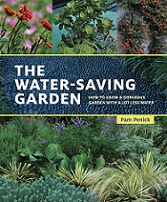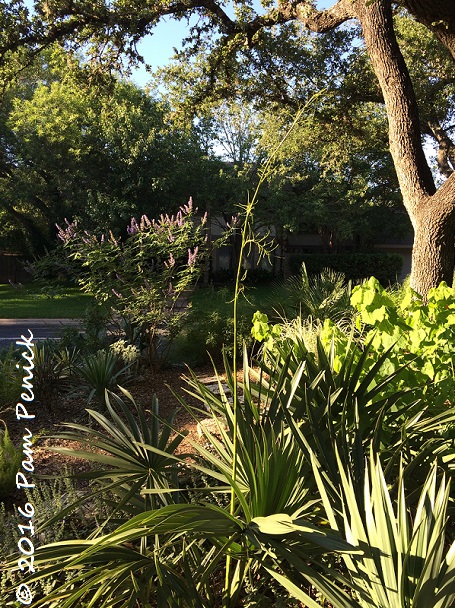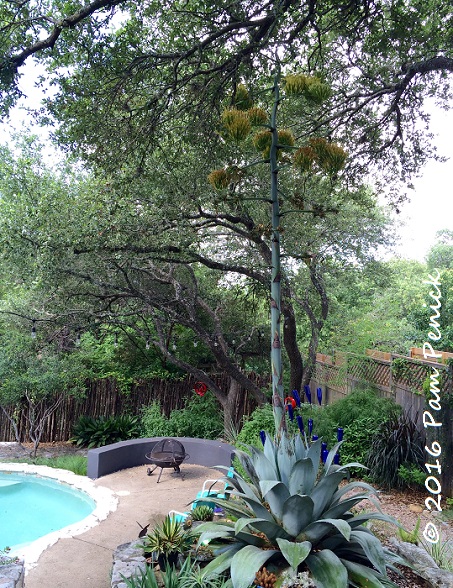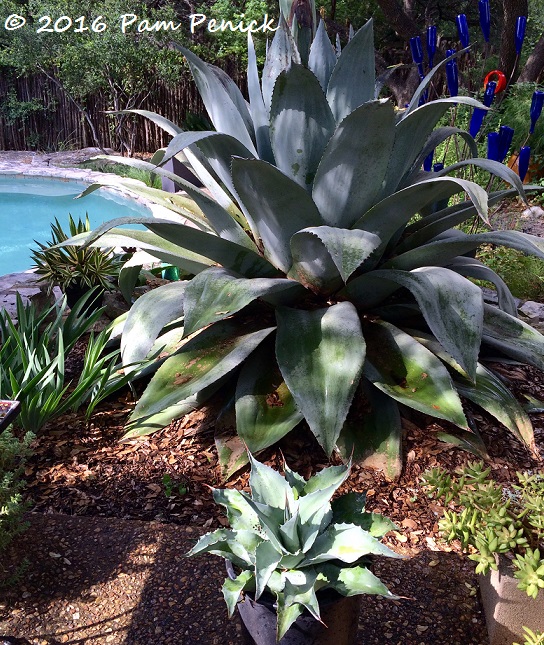Foliage plants in bloom for Foliage Follow-Up
Even plants we grow primarily for the beauty of their leaves and their form will flower. On this Foliage Follow-Up, I’m sharing two bold-foliage plants that are adding a jolt of drama with surprising bloom stalks.
One is dwarf Texas palmetto (Sabal minor), a native Texas plant that I’ve never seen in bloom before. Boy, was I surprised recently to see a slender, pliable flower spike arise from the heart of one of my sabals. Inconspicuous, cream-colored flowers are held on branching stems along the top of the spike. This is as showy as they get. Later, small black fruits should appear on the spike.
Regular readers know that Moby, my whale’s tongue agave (A. ovatifolia), is blooming — a tree-like flower spike that shot up to 15 feet in a matter of weeks. Tiers of yellow flowers are opening from bottom to top, with the lower-tier flowers already faded and dropped. The topmost flowers are still in bloom for now.
As dramatic as the bloom spike is, it presages Moby’s death, since agaves bloom just once and then die.
Moby’s beautiful blue-gray leaves still look pretty good for now. The plant hasn’t begun its inevitable collapse. But in preparation for that day, I now have a new Agave ovatifolia waiting in the wings — a lovely gift from horticulturist Nathan Unclebach at Hill Country Water Gardens & Nursery! Meet ‘Vanzie’, a wavy-leaved variety of the standard whale’s tongue, which will take Moby’s place when he dies.
This is my June post for Foliage Follow-Up. Fellow bloggers, what leafy loveliness is going on in your garden this month? Please join me in giving foliage its due on the day after Bloom Day. Leave a link to your post in a comment below. I’d appreciate it if you’ll also link to my post in your own — sharing link love! If you can’t post so soon after Bloom Day, no worries. Just leave your link when you get to it. I look forward to seeing your foliage faves.
I welcome your comments; please scroll to the end of this post to leave one. If you’re reading this in a subscription email, click here to visit Digging and find the comment box at the end of each post.
_______________________
Digging Deeper: News and Upcoming Events

All material © 2006-2016 by Pam Penick for Digging. Unauthorized reproduction prohibited.





Just two of the many watchers of Moby’s spectacular show here!
Thanks for following the action, M&G! —Pam
Rather than show one foliage plant I decided to concentrate on a section of the garden where the foliage is looking rather nice at the moment: http://eachlittleworld.typepad.com/each_little_world/2016/06/foliage-follow-up-6162016.html
Your foliage is always so interesting and I am awe over Moby, a plant I have become to love, which has given all of us such pleasure over the years. Also, a big welcome to ‘Vanzie’! My foliage is very different here on Long Island for Foliage Follow-Up. Here is my June garden at http://landscapedesignbylee.blogspot.com/2016/06/garden-bloggers-bloom-day-foliage.html#.V2Kt8LsrKU
Lee, your garden is so colorful at this time of year, and your shrubs and trees are a key part of the tapestry. I’m sorry to hear about the loss of your wisteria tree last winter though. —Pam
What an interesting flower Sabal minor has. Will Moby produce bubils? Will you obsessively pot them all up? ‘Vanzie’ looks like a handsome fellow. Will you keep that name, call it Moby II or come up with a whole new moniker? My Foliage Follow-Up post is here: http://outlawgarden.blogspot.com/2016/06/foliage-follow-up-june-2016.html
This is an interesting post as well: https://www.penick.net/digging/?p=8974
I don’t believe that whale’s tongue makes bulbils, nor does it offset pups. It’s all down to seed for this agave. —Pam
Glad you mention Sabals, Pam. They are Southeast US natives and flower easily, with each stem hosting hundreds of blooms that attract bees and other native insects, and then are followed by berries that the birds devour all winter. The thing with Sabals is that they grow in sun or shade and are easy and attractive with some maturity. The interesting thing is is that they’ve been dismissed too often by serious garden groups, environmentalists and garden writers as unworthy natives (talk about finding exclusivity in odd places and people) yet they attract the most bees/insects I’ve ever seen from one plant.
Unworthy? I never understand those kinds of judgments about plants. But I do understand not liking certain plants, which just comes down to personal taste. It actually took me a while to come around to palms, but now I have several. It’s good to know that sabals are so attractive to native pollinators and birds. —Pam
Your new book is mentioned in the new July issue of southern living?
Super exciting! Thanks for letting me know, Laura. I’m still waiting for my new issue to arrive. —Pam
I hope ‘Vanzie’ is up to the challenge of succeeding your Moby, Pam! So many of my foliage plants seem to be blooming as well this June but I did find a subject for this month’s foliage follow-up post: http://krispgarden.blogspot.com/2016/06/foliage-follow-up-aeoniums.html
I’m so envious of your ability to grow aeoniums, Kris. They are SO beautiful! But like many echeverias, they tend to melt away in our sweltering, humid summers. I’ll just enjoy them vicariously through your blog. —Pam